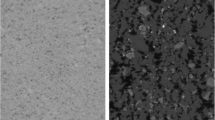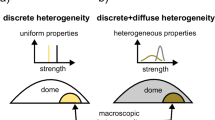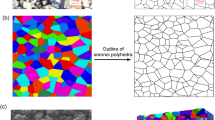Abstract
Volcanic rocks and magma display a wide range of porosity and vesicle size, a result of their complex genesis. While the role of porosity is known to exert a fundamental control on strength in the brittle field, less is known as to the influence of vesicle size. To help resolve this issue, here, we lean on a combination of micromechanical (Sammis and Ashby's pore-emanating crack model) and stochastic (rock failure and process analysis code) modelling. The models show, for a homogenous vesicle size, that an increase in porosity (in the form of circular vesicles, from 0 to 40 %) and/or vesicle diameter (from 0.1 to 2.0 mm) results in a dramatic reduction in strength. For example, uniaxial compressive strength can be reduced by about a factor of 5 as porosity is increased from 0 to 40 %. The presence of vesicles locally amplifies the stress within the groundmass and promotes the nucleation of vesicle-emanating microcracks that grow in the direction of the applied macroscopic stress. As strain increases, these microcracks continue to grow and eventually coalesce leading to macroscopic failure. Vesicle clustering, which promotes the overlap and interaction of the tensile stress lobes at the north and south poles of neighbouring vesicles, and the increased ease of microcrack interaction, is encouraged at higher porosity and reduces sample strength. Once a microcrack nucleates at the vesicle wall, larger vesicles impart higher stress intensities at the crack tips, allowing microcracks to propagate at a lower applied macroscopic stress. Larger vesicles also permit a shorter route through the groundmass for the macroscopic shear fracture. This explains the reduction in strength at higher vesicle diameters (at a constant porosity). The modelling highlights that the reduction in strength as porosity or vesicle size increases is nonlinear; the largest reductions are observed at low porosity and small vesicle diameters. In detail, we find that vesicle diameter can play an important role in dictating strength at low porosity but is largely inconsequential above 15 % porosity. Vesicle clustering and stress lobe interaction are implicit at high porosity, regardless of the vesicle diameter. In the case of an inhomogeneous vesicle size, the microcracks grow from the largest vesicles, and brittle strength is closer to that of the largest vesicle end-member. The results of this study highlight the important role of vesicle size, and the complex interplay between porosity and vesicle size, in controlling the brittle strength of volcanic rocks and magma.












Similar content being viewed by others
References
Al-Harthi AA, Al-Amri RM, Shehata WM (1999) The porosity and engineering properties of vesicular basalt in Saudi Arabia. Eng Geol 54:313–320
Amitrano, D., and A. Helmstetter (2006), Brittle creep, damage, and time to failure in rocks, J Geophys Res 111. doi:10.1029/2005JB004252
Baud P, Wong T-F, Zhu W (2013) Effects of porosity and crack density on the compressive strength of rocks. Int J Rock Mech Min. doi:10.1016/j.ijrmms.2013.1008.1031, In press
Baud P, Wong T-F, Zhu W (2014) Effects of porosity and crack density on the compressive strength of rocks. Int J Rock Mech Min. doi:10.1016/j.ijrmms.2013.1008.1031, In press
Brace WF, Paulding BW, Scholz CH (1966) Dilatancy in the fracture of crystalline rocks. J Geophys Res 71:3939–3953
Caricchi L, Pommier A, Pistone M, Castro J, Burgisser A, Perugini D (2011) Strain-induced magma degassing: insights from simple-shear experiments on bubble bearing melts. Bull Volcanol 73:1245–1257
Chang C, Zoback MD, Khaksar A (2006) Empirical relations between rock strength and physical properties in sedimentary rocks. J Pet Sci Eng 51:223–237
Cordonnier B, Caricchi L, Pistone M, Castro J, Hess K-U, Gottschaller S, Manga M, Dingwell DB, Burlini L (2012) The viscous-brittle transition of crystal-bearing silicic melt: direct observation of magma rupture and healing. Geology 40:611–614
Dingwell DB (1996) Volcanic dilemma–flow or blow? Science 273:1054–1055
Dingwell DB, Webb SL (1990) Relaxation in silicate melts. Eur J Mineral 2:427–449
Fakhimi A, Gharahbagh EA (2011) Discrete element analysis of the effect of pore size and pore distribution on the mechanical behavior of rock. Int J Rock Mech Min 48:77–85
Gondé C, Martel C, Pichavant M, Bureau H (2011) In situ bubble vesiculation in silicic magmas. AM Mineral 96:111–124
Gonnermann HM, Manga M (2003) Explosive volcanism may not be an inevitable consequence of magma fragmentation. Nature 426:432–435
Gonnermann, H. M., and M. Manga (2012), Dynamics of magma ascent in the volcanic conduit. In Fagents SA, GTKP, Lopes RMC (eds) Modeling volcanic processes: the physics and mathematics of volcanism. Cambridge University Press, Cambridge.
Gudmundsson A (2009) Toughness and failure of volcanic edifices. Tectonophysics 471:27–35
Gudmundsson A (2012) Strengths and strain energies of volcanic edifices: implications for eruptions, collapse calderas, and landslides. Nat Hazards Earth Syst Sci 12:2241–2258
Heap MJ, Lavallée Y, Petrakova L, Baud P, Reuschlé T, Varley N, Dingwell DB (2014) Microstructural controls on the physical and mechanical properties of edifice-forming andesites at Volcán de Colima, Mexico. J Geophys Res 119:2925–2963
Hoek E, Bieniawski ZT (1965) Brittle fracture propagation in rock under compression. Int J Fract 1:137–155
Jaeger J, Cook NGW, Zimmerman R (2007) Fundamentals in rock mechanics, 4th edn. Blackwell Publishing, London
Jaupart C (1998) Gas loss from magmas through conduit walls during eruption. Geol Soc Lond, Spec Publ 145:73–90
Kendrick JE, Lavallée Y, Hess K-U, Heap MJ, Gaunt HE, Meredith PG, Dingwell DB (2013) Tracking the permeable porous network during strain-dependent magmatic flow. J Volcanol Geotherm Res 260:117–126
Kolzenburg S, Heap MJ, Lavallée Y, Russell JK, Meredith PG, Dingwell DB (2014) Strength and permeability recovery of tuffisite-bearing andesite. Solid Earth 3:191–198
Kueppers U, Scheu B, Spieler O, Dingwell DB (1995) Field-based density measurements as tool to identify preeruption dome structure: set-up and first results from Unzen volcano, Japan. J Volcanol Geotherm Res 141:65–75
Lacroix P, Amitrano D (2013) Long-term dynamics of rockslides and damage propagation inferred from mechanical modeling. J Geophys Res 118:2292–2307
Laumonier M, Arbaret L, Burgisser A, Champallier R (2011) Porosity redistribution enhanced by strain localisation in crystal-rich magmas. Geology 39:715–718
Lavallée Y, Hess K-U, Cordonnier B, Dingwell DB (2007) A non-Newtonian rheological flow law for highly-crystalline dome lavas. Geology 35:843–846
Lavallée Y, Benson PM, Heap MJ, Hess K-U, Flaws A, Schillinger B, Meredith PG, Dingwell DB (2013) Reconstructing magma failure and the degassing network of dome-building eruptions. Geology 41:515–518
Lemaitre J, Chaboche J-L (1990) Mechanics of solid materials. Cambridge University Press, Cambridge
Liu D-M (1997) Influence of porosity and pore size on the compressive strength of porous hydroxyapatite ceramic. Ceram Int 23:135–139
Lockner D (1993) The role of acoustic emission in the study of rock fracture. Int J Rock Mech Min Sci Geomech Abstr 30(7):883–889
Mangan M, Cashman KVN (1993) Vesiculation of basaltic magma during eruption. Geology 21:157–160
Martel C, Dingwell DB, Spieler O, Pichavant M, Wilke M (2000) Fragmentation of foamed silicic melts: an experimental study. Earth Planet Sci Lett 178:47–58
Martel C, Dingwell DB, Spieler O, Pichavant M, Wilke M (2001) Experimental fragmentation of crystal- and vesicle-bearing silicic melts. Bull Volcanol 63:398–405
Mueller S, Scheu B, Spieler O, Dingwell DB (2008) Permeability control on magma fragmentation. Geology 36:399–402
Navon O, Lyakhovsky V (1998) Vesiculation processes in silicic magmas. Geol Soc Lond, Spec Publ 145:27–50
Pistone M, Caricchi L, Ulmer P, Burlini L, Ardia P, Reusser E, Marone F, Arbaret L (2012) Deformation experiments of bubble- and crystal-bearing magmas: rheological and microstructural analysis. J Geophys Res 117, B05208. doi:10.1029/2011JB008986
Reid ME, Keith TEC, Kayan RE, Iverson NR, Iverson RM, Brien DL (2010) Volcano collapse promoted by progressive strength reduction: new data from Mount St. Helens. Bull Volcanol 72:761–766
Sammis CG, Ashby MF (1986) The failure of brittle porous solids under compressive stress states. Acta Metall Mater 34:511–526
Scholz CH (1968a) Microfracturing and the inelastic deformation of rock in compression. J Geophys Res 73:1417–1432
Scholz CH (1968b) Microfractures, aftershocks, and seismicity. Bull Seismol Soc Am 58:1117–1130
Shea T, Houghton BF, Gurioli L, Cashman KV, Hammer JE, Hobden BJ (2010) Textural studies of vesicles in volcanic rocks: an integrated methodology. J Volcanol Geotherm Res 190:271–289
Sparks RSJ (1978) The dynamics of bubble formation and growth in magmas: a review and analysis. J Volcanol Geotherm Res 3:1–37
Spieler O, Kennedy B, Kueppers U, Dingwell DB, Scheu B, Taddeucci J (2004) The fragmentation threshold of pyroclastic rocks. Earth Planet Sci Lett 226:139–148
Stanchits S, Vinciguerra S, Dresen G (2006) Ultrasonic velocities, acoustic emission characteristics and crack damage of basalt and granite. Pure Appl Geophys 163:974–993
Tang CA (1997) Numerical simulation of progressive rock failure and associated seismicity. Int J Rock Mech Min 34:249–261
Tang CA, Huang ML, Zhao XD (2003) Weak zone related seismic cycles in progressive failure leading to collapse in brittle crust. Pure Appl Geophys 160:2319–2328
Toramaru A (1989) Vesiculation process and bubble size distributions in ascending magmas with constant velocities. J Geophys Res 94(B12):17523–17542
Vasseur J, Wadsworth FB, Lavallée Y, Hess K-U, Dingwell DB (2013) Volcanic sintering: timescales of viscous densification and strength recovery. Geophys Res Lett 40:5658–5664
Voight B (2000) Structural stability of andesite volcanoes and lava domes. Causes consequences eruptions andesite volcanoes. Philos T Roy Soc A 358(1770):1663–1703
Voight B, Elsworth D (2000) Instability and collapse of hazardous gas-pressurized lava domes. Geophys Res Lett 27:1–4
Weibull W (1951) A statistical distribution function of wide applicability. J Appl Mech 18:293–297
Wiederhorn SM (1969) Fracture surface energy of glass. J Am Ceram Soc 52(2):99–105
Wong T-F, Baud P (2012) The brittle-ductile transition in rocks: a review. J Struct Geol 44:25–53
Wong T-F, Wong RHC, Chau KT, Tang CA (2006) Microcrack statistics, Weibull distribution and micromechanical modeling of compressive failure in rock. Mech Mater 38:664–681
Wright HMN, Cashman KV, Gottesfeld EH, Roberts JJ (2009) Pore structure of volcanic clasts: measurements of permeability and electrical conductivity. Earth Planet Sci Lett 280:93–104
Xu T, C-A Tang (2008) Modeling of stress-induced permeability evolution and damage of rock, Adv Mater Res 33–37: 609–616
Xu T, Tang CA, Yang TH, Zhu WC, Liu J (2006) Numerical investigation of coal and gas outbursts in underground collieries. Int J Rock Mech Min 43:905–919
Xu T, Tang C-A, Zhao J, Li L, Heap MJ (2012) Modelling the time-dependent rheological behaviour of heterogeneous brittle rocks. Geophys J Int 189:1781–1796
Xu XH, Ma SP, Xia MF, Ke FJ, Bai YL (2004) Damage evaluation and damage localization of rock. Theor Appl Fract Mech 42:131–138
Zhang Y (1999) A criterion for the fragmentation of bubbly magma based on brittle failure theory. Nature 402:648–650
Zhu W, Baud P, Wong T-F (2010) Micromechanics of cataclastic pore collapse in limestone. J Geophys Res. doi:10.1029/2009JB006610
Zhu W, Baud P, Vinciguerra S, Wong T-F (2011) Micromechanics of brittle faulting and cataclastic flow in Alban Hills tuff, J Geophys Res 116 (B06209). doi:06210.01029/02010JB008046.
Acknowledgments
The idea for this paper was inspired by the comments of an anonymous reviewer. The authors of this study acknowledge the support of a Partenariats Hubert Curien (PHC) Xu Guangqi grant (grant number 32195NC), managed by Campus France and supported by the Ministry of Foreign Affairs (MAE) in France and the French Institute of the Chinese Embassy of France in China. Tao Xu acknowledges the National Natural Science Foundation of China (grant number 51474051). This work has benefitted from discussions with Kelly Russell, Patrick Baud, Alexandra Kushnir, Jamie Farquharson, Fabian Wadsworth, Nicolas Brantut, and Olivier Lengliné. We would like to thank Jackie Kendrick, Jérémie Vasseur and the editor, August Gudmundsson, for helpful comments and suggestions that improved this manuscript.
Author information
Authors and Affiliations
Corresponding author
Additional information
Editorial responsibility: A. Gudmundsson
Rights and permissions
About this article
Cite this article
Heap, M.J., Xu, T. & Chen, Cf. The influence of porosity and vesicle size on the brittle strength of volcanic rocks and magma. Bull Volcanol 76, 856 (2014). https://doi.org/10.1007/s00445-014-0856-0
Received:
Accepted:
Published:
DOI: https://doi.org/10.1007/s00445-014-0856-0




